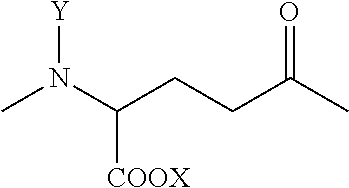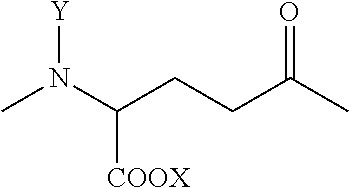High Water-Absorption and Anti-Bacterial Fibers
a fiber and high water absorption technology, applied in animal housing, transportation and packaging, animal husbandry, etc., can solve the problems of toxic monomer and base residue release, complicated preparation, limited application, etc., and achieve high water absorption, high water absorption, and antibacterial properties.
- Summary
- Abstract
- Description
- Claims
- Application Information
AI Technical Summary
Benefits of technology
Problems solved by technology
Method used
Image
Examples
embodiment 1
[0033]The γ-PGA fibers were immersed in 0.3 wt % sodium hypochlorite solution at a pH of 6-8 adjusted by 0.5 N phosphoric acid solution for 1 minute and then taken out. The fibers were rinsed with distilled water, put aside to be dried, and then detected with X-ray Energy Dispersive Spectrometer (EDS) for the increment ratio of chloride ions before and after immersing, to measure the content ratio of the modified γ-PGA segment to the unmodified γ-PGA segment.
embodiment 2
[0034]The γ-PGA fibers were immersed in 0.16 wt % sodium hypochlorite solution at a pH adjusted to 6-8 with 0.5 N phosphoric acid solution for 4 minutes, and then taken out. The fibers were rinsed with distilled water, put aside to be dried, and then detected with X-ray Energy Dispersive Spectrometer (EDS) for the increment ratio of chloride ions before and after immersing, to measure the content ratio of the modified γ-PGA segment to the unmodified γ-PGA segment.
embodiment 3
[0035]The γ-PGA fibers were immersed in 0.078 wt % sodium hypochlorite solution at a pH adjusted to 6-8 with 0.5 N phosphoric acid solution for 7 minutes, and then taken out. The fibers were rinsed with distilled water, put aside to be dried, and then detected with X-ray Energy Dispersive Spectrometer (EDS) for the increment ratio of chloride ions before and after immersing, to measure the content ratio of the modified γ-PGA segment to the unmodified γ-PGA segment.
PUM
| Property | Measurement | Unit |
|---|---|---|
| molar ratio | aaaaa | aaaaa |
| temperature | aaaaa | aaaaa |
| molar ratio | aaaaa | aaaaa |
Abstract
Description
Claims
Application Information
 Login to View More
Login to View More - R&D
- Intellectual Property
- Life Sciences
- Materials
- Tech Scout
- Unparalleled Data Quality
- Higher Quality Content
- 60% Fewer Hallucinations
Browse by: Latest US Patents, China's latest patents, Technical Efficacy Thesaurus, Application Domain, Technology Topic, Popular Technical Reports.
© 2025 PatSnap. All rights reserved.Legal|Privacy policy|Modern Slavery Act Transparency Statement|Sitemap|About US| Contact US: help@patsnap.com



